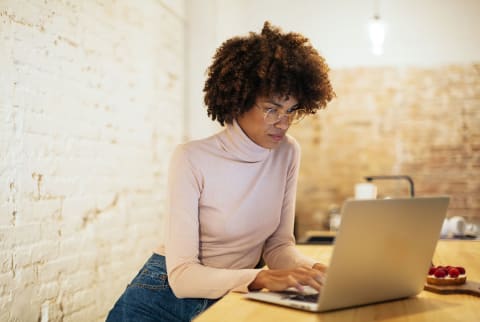Advertisement
A 20-Second Vision Exercise To Reduce Eye Strain, From An Optometrist


As much as we may hate to admit it sometimes, our world is existing more and more online. You can find screens pretty much everywhere: in your home, in your office, and even in the palm of your hands. That being said, it's not always easy to disconnect.
But, alas, increased screen time is a reality for many. However, staring at a screen for hours on end can actually contribute to eye strain over time if you're not careful.
So what can you do? Luckily, board-certified optometrist Bryce Appelbaum, O.D., FCOVD, shared an easy hack on an episode of the mindbodygreen podcast—here's what he suggests.
Do this to reduce eye strain
Your eyes contain small muscles, which means they're also prone to strain. Think of focusing, whether it be reading, writing, or even watching something up close or far away, as working your eye muscles.
When those teeny muscles are hard at work, that's when they're most likely to run into straining issues. Of course, limiting screen time can help, but you may also want to consider taking regular vision breaks: "We should be employing the 20-20-20 rule," Appelbaum says. "Which means taking a break every 20 minutes, looking at something at least 20 feet away, for at least 20 seconds."
Let's break that down:
- Check the clock: If you want to dedicate your effort to consistent vision breaks, then do your best to keep an eye on the clock throughout the day. Start at a time that's easy to track, say 10 a.m. rather than 9:47 a.m. Then every 20 minutes you'll know it's time for a quick break. If you want, a timer can help with consistency as well, but it may become a nuisance throughout the day.
- Pick a focal point: Once the clock strikes, find something to gaze at that's at least 20 feet away. If you're facing a wall without a window, this might mean getting up and looking outside for a few moments. The important thing is to focus on something that makes your eyes feel relaxed and is not another screen like a TV or phone. If you struggle to see long-distance, then pick something closer to you that you can actually focus on.
- Look for 20 seconds: The final step: Keep your eyes on the view for at least 20 seconds. This doesn't have to be exact, and you can even extend your break to a minute or so if you feel the need. You might even find this break relaxing, letting it double as a mindfulness moment. Up to you.
Think of your vision break like this: If you were to squeeze your hand in a fist, the muscles in your hand would begin to get tired and weaken after a few seconds. However, if you open your fist and close it again, you can maintain the fist for much longer, Appelbaum says.
The same goes for your eye muscles. When your eyes engage with screens, the pupil gets smaller, as the muscles are engaged, he says. "That's the equivalent to squeezing a fist." This is why it's essential for those sitting at the computer all day to incorporate vision breaks when possible. You wouldn't sit all day with tightly clenched fists, would you?
If you want to invest in your eye health even more, there are plenty of other exercises and supplements out there to help check that box. From antioxidants to combat oxidative stress and even nutrients that mitigate dry eyes from within, you're sure to find the right pick: Check out these 10 best eye supplements on the market.
The takeaway
Let's be honest: Avoiding screens completely is not realistic for everyone. As we navigate our increasingly digital world, it's important to take your eye health into account and incorporate this exercise (among others) when you can.